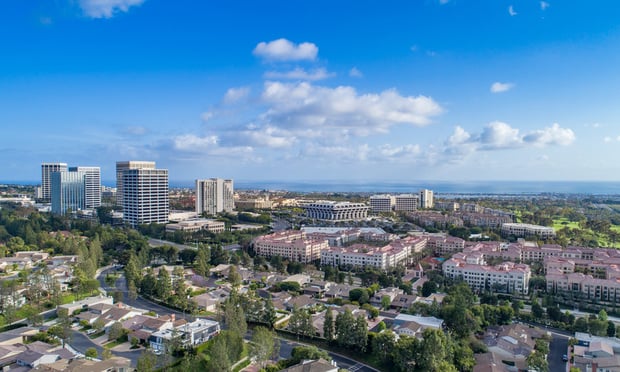ORANGE COUNTY, CA—The Greater Los Angeles and Orange County region is perhaps the greatest innovator and influencer of taste in the world, from design and architecture to music and technology, Cushman & Wakefield's Andrew McDonald tells GlobeSt.com. (Andrew McDonald is a panelist at RealShare Los Angeles on March 24.)
We spoke with McDonald after he was recently promoted to executive managing director and market leader of Greater Los Angeles-Orange County to get his take on major themes he is seeing for commercial real estate in the region and his outlook for its future.
GlobeSt.com: What are your goals in your new role with Cushman & Wakefield?
McDonald: First, we are incredibly fortunate to have the best leadership team in Southern California. Dan Broderick in San Diego, Jim McFadden in Orange County, Phil Lombardo in the Inland Empire and Eric Olofson in West L.A. are four of our industry's best market leaders. Continuing to leverage each of their abilities and relationships will be paramount as we drive increased value for our clients.
It is a region that we clearly believe has significant upside for our firm. While Cushman & Wakefield is well established in the region—and year after year is fortunate to advise on many of the largest and most-complex real estate transactions—we have room to grow. So, recruiting strategic top talent is a key initiative. To that end, I think you will see continued investment in all of our service lines, with perhaps increased attention paid to our capital-markets platform and lease transaction advisory services.
Harnessing the combined horsepower of the combined, legacy DTZ and Cushman & Wakefield is a goal for us all. Research and marketing are of particular importance to me. We have made a significant investment in our primary research capabilities, with the goal of doing a better job at collecting the incredible amount of data output from each of our service lines, resulting in greater insight on trends for our clients. Our clients want our researched opinions on “what's next.” They deserve insightful commentary. I think the work we continue to do within our research department will distinguish us.
On the marketing side, we are working hard to better deliver messaging on behalf of our investor clients. Much of what has been successful in the past will continue to serve its purpose, but our heavy investment in technology in 2016 will aid investor clients and enable our brokerage professionals to deliver our value proposition in new and exciting ways.
GlobeSt.com: What do you see as the major commercial real estate themes in the Los Angeles and Orange County markets?
McDonald: The growth of the on-demand-economy continues to inspire how we deliver our services. We produce some of the industry's best thought pieces on the remarkable technological, economic and cultural changes that influence not only the future of our workplace but the future of logistics and retail.
So, while the future of our workplace is a universal conversation, it is a major component of the advisory services we deliver here in this region.
The greater L.A./Orange County region is perhaps the greatest innovator and influencer of taste in the world. Design, architecture, art, entertainment, fashion and music are not just significant pieces of the L.A./Orange County economic fabric, but in many ways, it is what defines us. The confluence of aesthetics and commerce with our entrepreneurial “can-do' spirit will always be a theme for the region.
In some respects, our region is a logistics economy, and our work with the ports, large retailers and manufacturers is a big piece of our business. It's difficult to discuss this region and not cover the importance that logistics plays.
GlobeSt.com: What is your outlook for this region for 2016?
McDonald: First, the fight for density intensifies. Within the city of L.A., our outdated city-planning guidelines can't accommodate the need for more housing units, which only further hinders the connectivity with our expanding public transportation system. We need greater focus and buy-in to support density where it makes sense, primarily in the major employment centers.
Second, capital demand for the region is increasing. We boast a strong and diversified regional economy, which has become increasingly attractive to technology firms. Our ideal climate, improving infrastructure, educated workforce, diverse employer base and established entrepreneurial spirit will continue to draw capital to real estate.
Third, technology will settle in. We have already seen the second generation of technology startups in the region, and the flight of talent from other smart cities to L.A. is well documented. Our region has a long and distinguished history with technology companies, so perhaps we shouldn't be surprised. But the influence that tech will play in our region over the next five to seven years will be structural and forever change the landscape of L.A. and OC.
In sum, I see blue skies. Perhaps the L.A. Times and N.Y. Times business columnist James Flanigan said it best: “Smile, Southern California; you're the center of the universe.”
Want more insights from McDonald? Join the conversation at RealShare LOS ANGELES on March 24. Click here for more details or to register.
ORANGE COUNTY, CA—The Greater Los Angeles and Orange County region is perhaps the greatest innovator and influencer of taste in the world, from design and architecture to music and technology, Cushman & Wakefield's Andrew McDonald tells GlobeSt.com. (Andrew McDonald is a panelist at RealShare Los Angeles on March 24.)
We spoke with McDonald after he was recently promoted to executive managing director and market leader of Greater Los Angeles-Orange County to get his take on major themes he is seeing for commercial real estate in the region and his outlook for its future.
GlobeSt.com: What are your goals in your new role with Cushman & Wakefield?
McDonald: First, we are incredibly fortunate to have the best leadership team in Southern California. Dan Broderick in San Diego, Jim McFadden in Orange County, Phil Lombardo in the Inland Empire and Eric Olofson in West L.A. are four of our industry's best market leaders. Continuing to leverage each of their abilities and relationships will be paramount as we drive increased value for our clients.
It is a region that we clearly believe has significant upside for our firm. While Cushman & Wakefield is well established in the region—and year after year is fortunate to advise on many of the largest and most-complex real estate transactions—we have room to grow. So, recruiting strategic top talent is a key initiative. To that end, I think you will see continued investment in all of our service lines, with perhaps increased attention paid to our capital-markets platform and lease transaction advisory services.
Harnessing the combined horsepower of the combined, legacy DTZ and Cushman & Wakefield is a goal for us all. Research and marketing are of particular importance to me. We have made a significant investment in our primary research capabilities, with the goal of doing a better job at collecting the incredible amount of data output from each of our service lines, resulting in greater insight on trends for our clients. Our clients want our researched opinions on “what's next.” They deserve insightful commentary. I think the work we continue to do within our research department will distinguish us.
On the marketing side, we are working hard to better deliver messaging on behalf of our investor clients. Much of what has been successful in the past will continue to serve its purpose, but our heavy investment in technology in 2016 will aid investor clients and enable our brokerage professionals to deliver our value proposition in new and exciting ways.
GlobeSt.com: What do you see as the major commercial real estate themes in the Los Angeles and Orange County markets?
McDonald: The growth of the on-demand-economy continues to inspire how we deliver our services. We produce some of the industry's best thought pieces on the remarkable technological, economic and cultural changes that influence not only the future of our workplace but the future of logistics and retail.
So, while the future of our workplace is a universal conversation, it is a major component of the advisory services we deliver here in this region.
The greater L.A./Orange County region is perhaps the greatest innovator and influencer of taste in the world. Design, architecture, art, entertainment, fashion and music are not just significant pieces of the L.A./Orange County economic fabric, but in many ways, it is what defines us. The confluence of aesthetics and commerce with our entrepreneurial “can-do' spirit will always be a theme for the region.
In some respects, our region is a logistics economy, and our work with the ports, large retailers and manufacturers is a big piece of our business. It's difficult to discuss this region and not cover the importance that logistics plays.
GlobeSt.com: What is your outlook for this region for 2016?
McDonald: First, the fight for density intensifies. Within the city of L.A., our outdated city-planning guidelines can't accommodate the need for more housing units, which only further hinders the connectivity with our expanding public transportation system. We need greater focus and buy-in to support density where it makes sense, primarily in the major employment centers.
Second, capital demand for the region is increasing. We boast a strong and diversified regional economy, which has become increasingly attractive to technology firms. Our ideal climate, improving infrastructure, educated workforce, diverse employer base and established entrepreneurial spirit will continue to draw capital to real estate.
Third, technology will settle in. We have already seen the second generation of technology startups in the region, and the flight of talent from other smart cities to L.A. is well documented. Our region has a long and distinguished history with technology companies, so perhaps we shouldn't be surprised. But the influence that tech will play in our region over the next five to seven years will be structural and forever change the landscape of L.A. and OC.
In sum, I see blue skies. Perhaps the L.A. Times and N.Y. Times business columnist James Flanigan said it best: “Smile, Southern California; you're the center of the universe.”
Want more insights from McDonald? Join the conversation at RealShare LOS ANGELES on March 24. Click here for more details or to register.
Want to continue reading?
Become a Free ALM Digital Reader.
Once you are an ALM Digital Member, you’ll receive:
- Breaking commercial real estate news and analysis, on-site and via our newsletters and custom alerts
- Educational webcasts, white papers, and ebooks from industry thought leaders
- Critical coverage of the property casualty insurance and financial advisory markets on our other ALM sites, PropertyCasualty360 and ThinkAdvisor
Already have an account? Sign In Now
*May exclude premium content© 2025 ALM Global, LLC, All Rights Reserved. Request academic re-use from www.copyright.com. All other uses, submit a request to [email protected]. For more information visit Asset & Logo Licensing.









